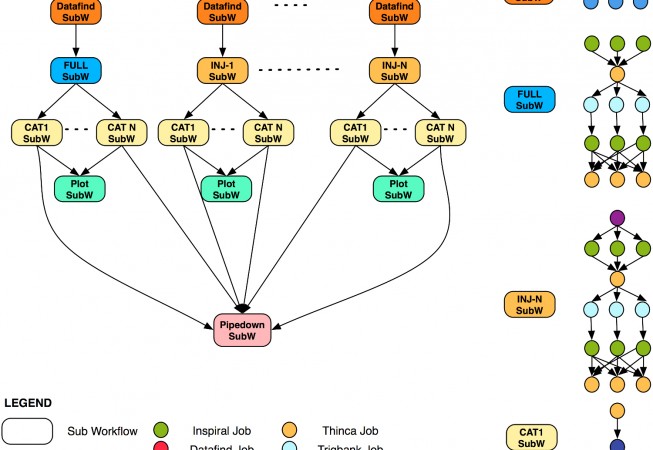Laser Interferometer Gravitational Wave Observatory (LIGO) is a network of gravitational-wave detectors, with observatories in Livingston, LA and Hanford, WA. The observatories’ mission is to detect and measure gravitational waves predicted by general relativity─Einstein’s theory of gravity─in which gravity is described as due to the curvature of the fabric of time and space. One well-studied phenomenon which is expected to be a source of gravitational waves is the inspiral and coalescence of a pair of dense, massive astrophysical objects such as neutron stars and black holes. Such binary inspiral signals are among the most promising sources for LIGO. Gravitational waves interact extremely weakly with matter, and the measurable effects produced in terrestrial instruments by their passage will be miniscule. In order to increase the probability of detection, a large amount of data needs to be acquired and analyzed which contains the strain signal that measures the passage of gravitational waves. LIGO applications often require on the order of a terabyte of data to produce meaningful results.
LIGO runs their inspiral workflows both on the LIGO Data Grid (LDG) and OSG. Although the workflows are smaller than SCEC”s in terms of numbers of tasks, they are much more data intensive, operating on Terabyte size data (in one workflow). Our flexible storage interfaces allowed us to integrate Pegasus with SRM, a storage solution used on OSG. LIGO leveraged this capability to automatically stage and access workflow input and output data via SRM using temporary local storage on each compute node. Currently LIGO can execute either on LDG or OSG resources.
The CBC group in LIGO used Pegasus as it’s workflow management tool for the sixth science run (S6) which observed data June 2009-October 2010. The Pegasus Team was part of a joint OSG LIGO taskforce that aimed to address the data management issues that arise while running the large-scale workflows on Open Science Grid (OSG).
The incorporation of the Pegasus into the production pipeline has enabled LIGO users to
- Separate their workflow logs directories from the execution directories. Their earlier pipeline required the logs to be the shared filesystem of the clusters. This resulted in scalability issues as the load on the NFS increased drastically when large workflows were launched.
- Easier debugging of their workflows.
- Ability to re-run analysis later on without running all the sub workflows from start. This leverages the data reuse capabilities of Pegasus. The users can now re-run the CAT workflows with different parameters without having to re-run the full data and inspiral sub workflows. LIGO data may need to be analyzed several times due to changed in e.g. detector calibration or data-quality flags. Complete re-analysis of the data is a very computationally intensive task. By using the workflow reduction capabilities of Pegasus, the LSC and Virgo have been able to re-use existing data products from previous runs, when those data products are suitable.
A single iHope workflow above consists of several large sub workflows each doing analysis on the same input dataset. Several advanced features of Pegasus are being used to optimize the run time of the iHope workflows as well as to make them run reliably. The features used are Job Clustering, Recursive Daxes,Throttling,Priorities,Job Retry,Workflow Retry,Data Clustering,Local Directory Execution.
Publications:
Article in ISGTW on searching for Gravitational Waves using Pegasus: Looking for gravitational waves: A computing perspective
Gurmeet Singh, Karan Vahi, Arun Ramakrishnan, Gaurang Mehta, Ewa Deelman, Henan Zhao, Rizos Sakellariou, Kent Blackburn, Duncan Brown, Stephen Fairhurst, David Meyers, G. Bruce Berriman. Optimizing Workflow Data Footprint Special issue of the Scientific Programming Journal dedicated to Dynamic Computational Workflows: Discovery, Optimisation and Scheduling, 2007.
Arun Ramakrishnan, Gurmeet Singh, Henan Zhao, Ewa Deelman, Rizos Sakellariou, Karan Vahi, Kent Blackburn , David Meyers and Michael Samidi. “Scheduling Data-Intensive Workflows onto Storage-Constrained Distributed Resources”, Seventh IEEE International Symposium on Cluster Computing and the Grid – CCGrid 2007
D. A. Brown, P. R. Brady, A. Dietz, J. Cao, B. Johnson, and J. McNabb, “A Case Study on the Use of Workflow Technologies for Scientific Analysis: Gravitational Wave Data Analysis,” in Workflows for e-Science, I. Taylor, et al., Eds., ed: Springer, 2006.
G Singh, E Deelman, G Mehta, K Vahi, Mei Su, B. Berriman, J Good, J Jacob, D Katz, A Lazzarini, K Blackburn, S Koranda, “The Pegasus Portal: Web Based Grid Computing” The 20th Annual ACM Symposium on Applied Computing, Santa Fe, New Mexico, March 13 -17, 2005
Ewa Deelman, James Blythe, Yolanda Gil, Carl Kesselman, Scott Koranda, Albert Lazzarini, Gaurang Mehta, Maria Alessandra Papa, Karan Vahi, Pegasus and the Pulsar Search: From Metadata to Execution on the Grid. Applications Grid Workshop, PPAM 2003, Czestochowa, Poland 2003
E. Deelman, C. Kesselman, G. Mehta, L. Meshkat, L. Pearlman, K. Blackburn, P. Ehrens, A. Lazzarini, R. Williams, S. Koranda. GriPhyN and LIGO, building a virtual data grid for gravitational wave scientists High Performance Distributed Computing, 2002. HPDC-11 2002. Page(s): 225 -234
Scientists: Duncan Brown (Syracuse), Kent Blackburn (Caltech), Britta Dauderts, Robert Engel (Caltech)
